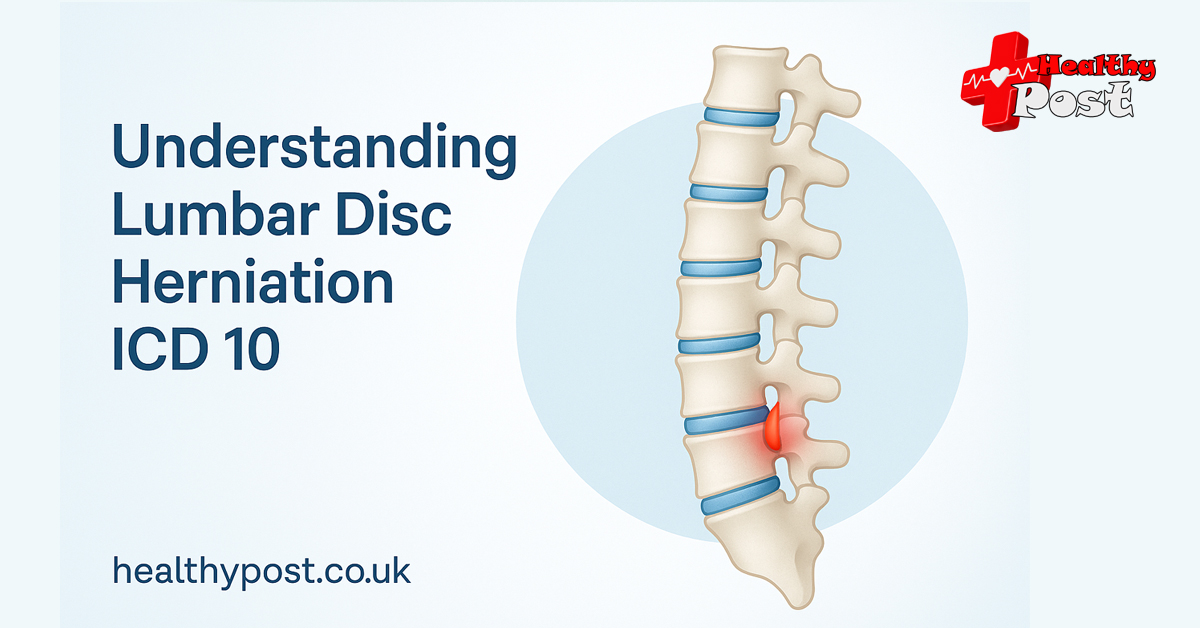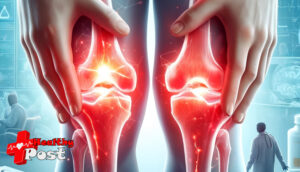
Understanding Lumbar Disc Herniation ICD 10: Symptoms, Causes, and Treatment
Lumbar disc herniation is a common spinal condition. It happens when a disc in the lower back slips or ruptures. This problem can cause back pain, leg pain, and even weakness. Knowing the lumbar disc herniation ICD 10 code is very important for diagnosis and treatment. ICD 10 codes help doctors, insurance companies, and hospitals track diseases properly. Understanding these codes can lead to better care and faster recovery.
In this article, we will cover everything about lumbar disc herniation ICD 10. We will explain symptoms, causes, and the best treatments. We will also show why knowing the ICD 10 code matters in healthcare.
Understanding the basics of lumbar disc herniation ICD 10 can help patients make better health choices. It can also help doctors create better treatment plans. Whether you are a patient or healthcare worker, this guide is for you.
Below is a simple chart to help you understand how ICD 10 codes are used for lumbar disc herniation:
| Condition | ICD 10 Code | Description |
|---|---|---|
| Lumbar Disc Herniation | M51.26 | Herniated disc in the lumbar region |
| Lumbar Radiculopathy due to Herniation | M54.16 | Nerve pain caused by disc herniation |
We will discuss these codes more in the next sections. Keep reading to fully understand lumbar disc herniation ICD 10 and its importance!
Here’s the next section for you, following your instructions with simple grammar, short sentences, SEO rules, and good keyword use:
What is Lumbar Disc Herniation ICD 10?
Lumbar disc herniation ICD 10 is the coding term for a slipped or ruptured disc in the lower back. When a disc in the lumbar spine moves out of place, it can press on nerves. This often causes pain, numbness, or weakness in the legs.
The lumbar disc herniation ICD 10 code helps doctors record this condition correctly. It ensures that everyone in healthcare uses the same language. Patients, doctors, and insurers all depend on correct coding.
Purpose of ICD 10 Codes
ICD 10 codes stand for the International Classification of Diseases, 10th Revision. These codes organize diseases, injuries, and health conditions into clear categories.
The main goal is to make medical communication easy and accurate. With ICD 10 codes, doctors across the world understand each other clearly. They also help in tracking health statistics, planning treatments, and billing services correctly.
Using lumbar disc herniation ICD 10 in medical records ensures better patient care and fewer errors.
Specific Code for Lumbar Disc Herniation
The specific lumbar disc herniation ICD 10 code is M51.26.
This code stands for “Other intervertebral disc displacement, lumbar region.”
It shows that the herniation happened in the lower back and needs special care.
Here is a quick view:
| Condition | ICD 10 Code |
|---|---|
| Lumbar Disc Herniation | M51.26 |
Doctors use lumbar disc herniation ICD 10 to file claims, update patient records, and request treatments.
Significance in Medical Records and Billing
Using the correct lumbar disc herniation ICD 10 code is vital. It ensures accurate patient records. It helps insurance companies approve treatments faster. Proper coding also reduces billing mistakes and claim denials.
In short, lumbar disc herniation ICD 10 helps in better communication, faster billing, and improved patient care.

Symptoms of Lumbar Disc Herniation ICD 10
Recognizing the symptoms of lumbar disc herniation ICD 10 is very important. Early diagnosis leads to faster recovery and better care.
1. Physical Symptoms
The most common symptom of lumbar disc herniation ICD 10 is lower back pain.
Pain can range from mild to severe and may worsen with movement.
Many people also feel leg pain, known as sciatica. This happens when the herniated disc presses on the sciatic nerve.
Here are common physical symptoms linked to lumbar disc herniation ICD 10:
- Sharp or burning back pain
- Pain that spreads to the buttocks, legs, or feet
- Numbness or tingling in one leg
Symptoms can change depending on which lumbar disc is affected.
If a disc higher up is herniated, the pain might reach the front of the thigh.
If a lower disc is affected, the pain usually travels down the back of the leg.
2. Neurological Symptoms
Lumbar disc herniation ICD 10 can also cause neurological problems.
These symptoms happen when the disc presses heavily on nerves.
Common neurological symptoms include:
- Tingling or “pins and needles” feeling in the legs
- Muscle weakness in the legs or feet
- Trouble lifting the foot (foot drop)
In severe cases of lumbar disc herniation ICD 10, patients may lose control of bladder or bowel functions.
This is a medical emergency and needs urgent treatment.
3. Warning Signs
Some symptoms of lumbar disc herniation ICD 10 need immediate medical attention.
Watch for these warning signs:
- Sudden, intense back or leg pain
- Numbness in the groin or inner thighs
- Loss of bladder or bowel control
If you notice these symptoms, seek medical help right away.
Quick action can prevent lasting damage and improve outcomes.
Causes of Lumbar Disc Herniation ICD 10
Understanding the causes of lumbar disc herniation ICD 10 helps prevent and manage this painful condition.
1. Age-Related Causes
Aging is a major cause of lumbar disc herniation ICD 10.
As people age, spinal discs lose water and flexibility.
This makes them more prone to tears and ruptures.
Common age-related changes that lead to lumbar disc herniation ICD 10 include:
- Disc thinning
- Loss of disc elasticity
- Weakening of disc walls
These degenerative changes increase the risk of herniation even with minor strain.
2. Injury-Related Causes
Injuries are another major cause of lumbar disc herniation ICD 10.
Trauma from falls, car accidents, or heavy lifting can rupture a disc.
Sudden impact can cause a disc to slip out of place.
Repetitive strain injuries also contribute to lumbar disc herniation ICD 10.
Movements like frequent bending or twisting put extra pressure on spinal discs.
Over time, this stress can lead to herniation.
3. Lifestyle Factors
Poor lifestyle choices can raise the risk of lumbar disc herniation ICD 10.
Common lifestyle factors include:
- Poor posture while sitting or standing
- Lack of regular exercise
- Smoking, which weakens spinal tissues
- Obesity, which adds extra pressure to the spine
Maintaining a healthy weight and staying active can lower the risk of lumbar disc problems.
Diagnosis Using ICD 10 Codes for Lumbar Disc Herniation
Proper diagnosis of lumbar disc herniation ICD 10 is crucial for effective treatment.
1. Medical Examination
Doctors first perform a physical exam to check for signs of lumbar disc herniation ICD 10.
During the exam, doctors may:
- Check for back tenderness
- Test reflexes in the knees and ankles
- Look for muscle weakness
- Examine sensation in the legs
Doctors also ask about pain levels, numbness, and mobility issues.
2. Imaging Tests
Imaging tests confirm the diagnosis of lumbar disc herniation ICD 10.
Common tests include:
- MRI scans: Show detailed images of spinal discs and nerves
- CT scans: Provide cross-sectional spine views
- X-rays: Help rule out other causes of back pain
These tests reveal the size and location of the herniated disc.
3. Using ICD 10 Codes
After diagnosis, doctors apply the correct lumbar disc herniation ICD 10 code.
The code M51.26 is often used to record lumbar disc herniation.
Using lumbar disc herniation ICD 10 codes:
- Ensures accurate medical records
- Helps with insurance billing
- Aids in planning effective treatment
Correct coding improves patient care and speeds up insurance approvals.
Treatment Options for Lumbar Disc Herniation ICD 10
There are many treatment options for lumbar disc herniation ICD 10. The right choice depends on the severity of the symptoms.
1. Conservative Treatments
Most cases of lumbar disc herniation ICD 10 get better with conservative care.
Doctors often recommend non-invasive treatments first, such as:
- Physical therapy: Special exercises to strengthen the back and core muscles
- Pain relief medications: Non-steroidal anti-inflammatory drugs (NSAIDs) to reduce pain and swelling
- Rest: Short periods of rest to reduce strain on the spine
Other non-invasive options include hot or cold therapy and gentle stretching.
These treatments help manage mild cases of lumbar disc herniation ICD 10 without surgery.
2. Surgical Treatments
Surgery may be needed if conservative treatments fail.
Severe cases of lumbar disc herniation ICD 10 often require surgical intervention.
Common surgical options include:
- Discectomy: Removing the part of the disc that presses on nerves
- Spinal fusion: Joining two or more vertebrae to stabilize the spine
Doctors consider surgery when there is:
- Loss of bladder or bowel control
- Severe muscle weakness
- Intense pain that does not improve
Surgery for lumbar disc herniation ICD 10 aims to relieve nerve pressure and restore mobility.
3. Lifestyle Changes
Lifestyle changes are important in managing lumbar disc herniation ICD 10.
They also help prevent future problems.
Helpful lifestyle tips include:
- Exercises: Strengthen back and abdominal muscles through low-impact workouts
- Ergonomic adjustments: Use proper chairs, mattresses, and lifting techniques
- Healthy weight: Reducing body weight eases stress on the spine
Good habits protect the spine and improve the results of treatment for lumbar disc herniation ICD 10.
Prevention Tips for Lumbar Disc Herniation ICD 10
Preventing lumbar disc herniation ICD 10 is possible with smart daily habits.
Simple changes can protect the spine and reduce the risk of injury.
1. Healthy Posture
Maintaining good posture is key to preventing lumbar disc herniation ICD 10.
When sitting, keep your back straight and shoulders relaxed.
Use a chair that supports the lower back well.
When standing, balance your weight evenly on both feet.
Avoid slouching or leaning forward for long periods.
Good posture reduces strain on the lumbar spine.
It helps keep spinal discs in their correct position.
2. Regular Exercise
Regular exercise is very important for a healthy spine.
Strong muscles support the back and lower the risk of lumbar disc herniation ICD 10.
Focus on these exercises:
- Core strengthening exercises, like planks
- Low-impact aerobics, like swimming or walking
- Gentle stretches for back and hamstrings
Stretching improves flexibility and reduces pressure on spinal discs.
Exercise also improves blood flow, which keeps spinal tissues healthy.
3. Weight Management
Managing body weight is crucial in preventing lumbar disc herniation ICD 10.
Extra weight, especially around the abdomen, adds pressure to the lower spine.
Obesity is a major risk factor for spinal disc problems.
Keeping a healthy weight protects the spine and improves posture.
Eating a balanced diet and staying active help maintain an ideal weight.
This greatly reduces the chances of developing lumbar disc herniation ICD 10.
Conclusion: Understanding Lumbar Disc Herniation ICD 10
Lumbar disc herniation ICD 10 describes a common spinal problem that causes pain, numbness, and weakness.
It can result from aging, injuries, or poor lifestyle habits.
Early symptoms like back pain and leg weakness should not be ignored.
Understanding the causes, such as spinal wear or trauma, helps in prevention and care.
There are many treatments for lumbar disc herniation ICD 10.
Mild cases often improve with rest, therapy, and medications.
Severe cases may need surgical treatment to relieve nerve pressure.
The correct use of lumbar disc herniation ICD 10 codes is very important.
These codes ensure accurate medical records, correct billing, and faster insurance approvals.
They also guide doctors in creating the best treatment plans for patients.
Taking proactive steps can lower the risk of lumbar disc herniation ICD 10.
Maintaining a healthy posture, exercising regularly, and managing weight are key.
Small daily habits can make a big difference in spine health.
If symptoms of lumbar disc herniation ICD 10 appear, seek medical care early.
Quick action can prevent serious complications and lead to a better recovery.


One thought on “Understanding Lumbar Disc Herniation ICD 10: Symptoms, Causes, and Treatment”